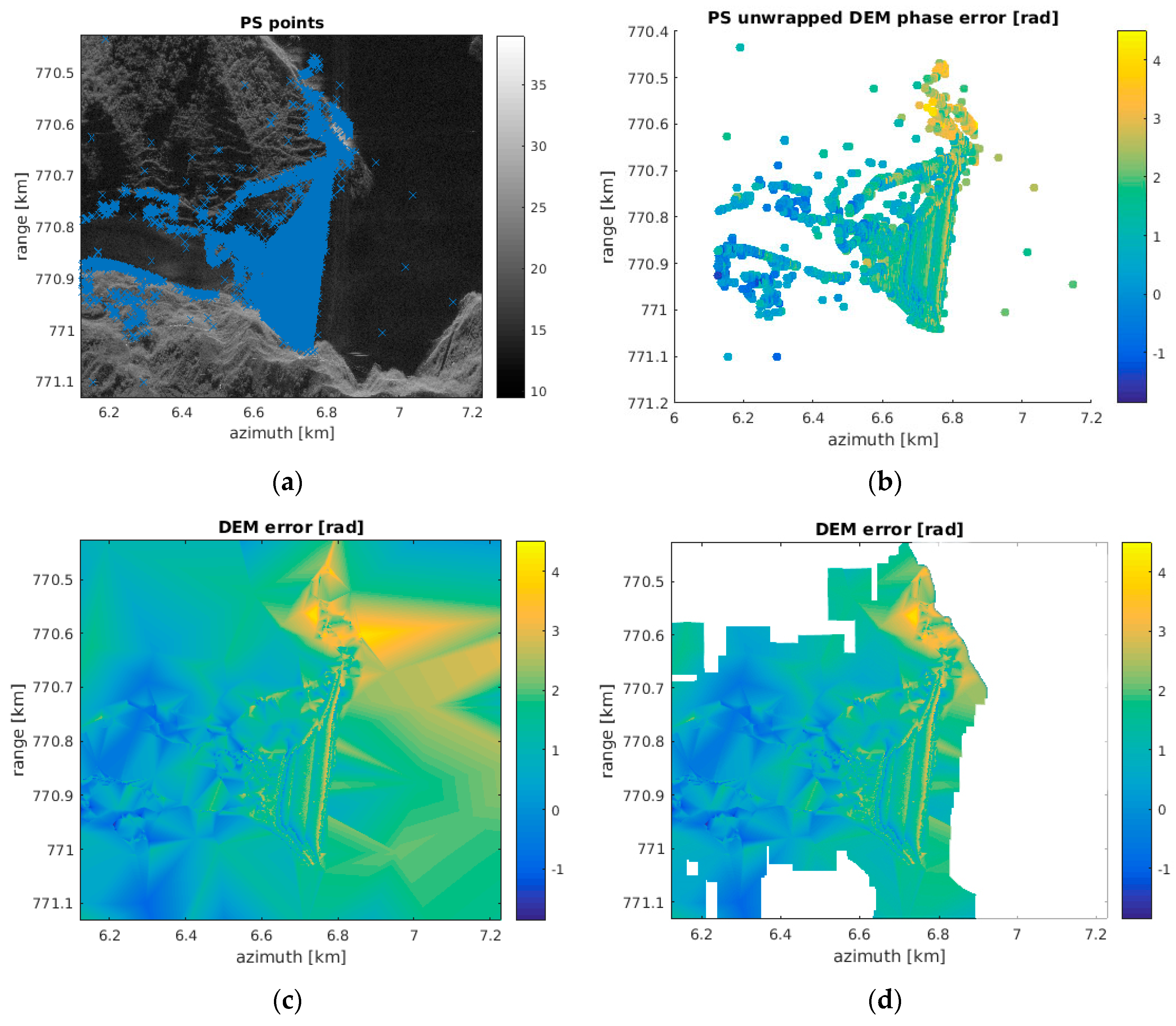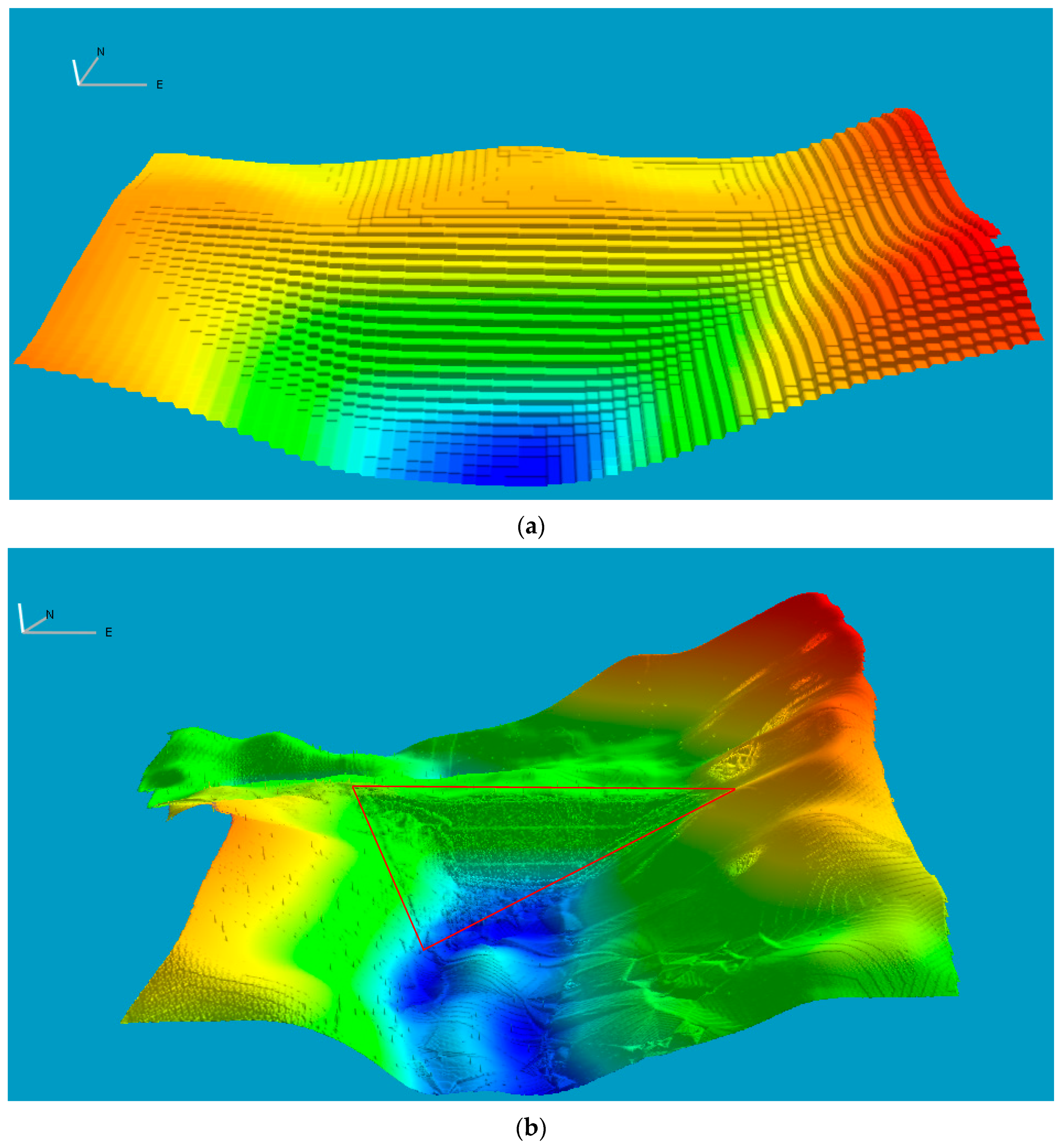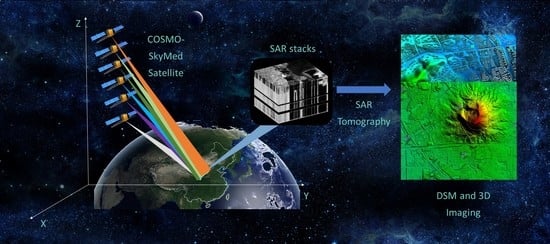Elevation Extraction from Spaceborne SAR Tomography Using Multi-Baseline COSMO-SkyMed SAR Data
Abstract
:1. Introduction
2. Methodology
2.1. Principles
2.2. SAR Interferometry Phase (InSAR) Calibration with DEM Error
2.3. The Compressive Sensing Method
3. Results
3.1. Test Sites and COSMO-SkyMed Spaceborne SAR
3.2. TomoSAR Results and Fieldwork for Validation
4. Discussion
5. Conclusions
Author Contributions
Funding
Data Availability Statement
Acknowledgments
Conflicts of Interest
References
- Reigber, A.; Moreira, A. First demonstration of airborne SAR tomography using multibaseline L-band data. IEEE Trans. Geosci. Remote Sens. 2000, 38, 2142–2152. [Google Scholar] [CrossRef]
- Fornaro, G.; Serafino, F.; Soldovieri, F. Three-dimensional focusing with multipass SAR data. IEEE Trans. Geosci. Remote Sens. 2003, 41, 507–517. [Google Scholar] [CrossRef]
- Nannini, M.; Scheiber, R.; Horn, R. Imaging of targets beneath foliage with SAR tomography. In Proceedings of the EUSAR 2008: 7th European Conference on Synthetic Aperture Radar, Friedrichshafen, Germany, 2–5 June 2008; pp. 1–4. [Google Scholar]
- Lombardini, F.; Cai, F.; Pasculli, D. Spaceborne 3-D SAR tomography for analyzing garbled urban scenarios: Single-look superresolution advances and experiments. IEEE J. Sel. Top. Appl. Earth Obs. Remote Sens. 2013, 6, 960–968. [Google Scholar] [CrossRef]
- Lombardini, F.; Cai, F. Evolutions of Diff-Tomo for Sensing Subcanopy Deformations and Height-Varying Temporal Coherence. In Proceedings of the Fringe 2011, Frascati, Italy, 19–23 September 2011; p. 43. [Google Scholar]
- Lombardini, F. Differential tomography: A new framework for SAR interferometry. IEEE Trans. Geosci. Remote Sens. 2005, 43, 37–44. [Google Scholar] [CrossRef]
- Lombardini, F.; Pardini, M. Superresolution differential tomography: Experiments on identification of multiple scatterers in spaceborne SAR data. IEEE Trans. Geosci. Remote Sens. 2012, 50, 1117–1129. [Google Scholar] [CrossRef]
- Lombardini, F.; Viviani, F.; Cai, F.; Dini, F. Forest Temporal Decorrelation: 3D Analyses and Processing in the Diff-Tomo Framework. In Proceedings of the Geoscience and Remote Sensing Symposium (IGARSS), 2013 IEEE International, Melbourne, Australia, 21–26 July 2013; pp. 1202–1205. [Google Scholar]
- Tebaldini, S.; Rocca, F. Multibaseline polarimetric SAR tomography of a boreal forest at P-and L-bands. IEEE Trans. Geosci. Remote Sens. 2012, 50, 232–246. [Google Scholar] [CrossRef]
- Piau, P. Performances of the 3D-SAR Imagery. In Proceedings of the IGARSS ’94—1994 IEEE International Geoscience and Remote Sensing Symposium, Pasadena, CA, USA, 8–12 August 1994; pp. 2267–2271. [Google Scholar]
- Jakowatz, C.V.; Thompson, P. A new look at spotlight mode synthetic aperture radar as tomography: Imaging 3-D targets. IEEE Trans. Image Process. 1995, 4, 699–703. [Google Scholar] [CrossRef] [PubMed]
- Homer, J.; Longstaff, I.; She, Z.; Gray, D. High resolution 3-D imaging via multi-pass SAR. IEEE Proc.-Radar Sonar Navig. 2002, 149, 45–50. [Google Scholar] [CrossRef] [Green Version]
- Pasquali, P.; Prati, C.; Rocca, F.; Seymour, M.; Fortuny, J.; Ohlmer, E.; Sieber, A. A 3-D Sar Experiment with EMSL Data. In Proceedings of the 1995 International Geoscience and Remote Sensing Symposium, IGARSS 95. Quantitative Remote Sensing for Science and Applications, Firenze, Italy, 10–14 July 1995; pp. 784–786. [Google Scholar]
- Zhu, X.X.; Bamler, R. Very high resolution spaceborne SAR tomography in urban environment. IEEE Trans. Geosci. Remote Sens. 2010, 48, 4296–4308. [Google Scholar] [CrossRef] [Green Version]
- Zhu, X.X.; Bamler, R. Tomographic SAR inversion by L1 norm regularization—The compressive sensing approach. IEEE Trans. Geosci. Remote Sens. 2010, 48, 3839–3846. [Google Scholar] [CrossRef] [Green Version]
- Xiang, Z.X.; Bamler, R. Compressive Sensing for High Resolution Differential SAR Tomography-the SL1MMER algorithm. In Proceedings of the Geoscience and Remote Sensing Symposium (IGARSS), 2010 IEEE International, Honolulu, HI, USA, 25–30 July 2010; pp. 17–20. [Google Scholar]
- Fornaro, G.; Reale, D.; Serafino, F. Four-dimensional SAR imaging for height estimation and monitoring of single and double scatterers. Geosci. Remote Sens. IEEE Trans. 2009, 47, 224–237. [Google Scholar] [CrossRef]
- Huang, Y.; Ferro-Famil, L.; Reigber, A. Under-foliage object imaging using SAR tomography and polarimetric spectral estimators. IEEE Trans. Geosci. Remote Sens. 2012, 50, 2213–2225. [Google Scholar] [CrossRef] [Green Version]
- Huang, Y.; Ferro-Famil, L.; Reigber, A. Under-foliage target detection using multi-baseline L-band PolInSAR data. In Proceedings of the 2013 14th International Radar Symposium (IRS), Dresden, Germany, 19–21 June 2013; pp. 449–454. [Google Scholar]
- Zhu, X.X.; Bamler, R. Tomographic SAR inversion from mixed repeat- and single-Pass data stacks—The TerraSAR-X/TanDEM-X case. In Proceedings of the XXII ISPRS Congress, Melbourne, Australia, 25 August–1 September 2012. [Google Scholar]
- Ferro-Famil, L.; Leconte, C.; Boutet, F.; Phan, X.-V.; Gay, M.; Durand, Y. PoSAR: A VHR tomographic GB-SAR system application to snow cover 3-D imaging at X and Ku bands. In Proceedings of the 2012 9th European Radar Conference, Amsterdam, The Netherlands, 31 October–2 November 2012; pp. 130–133. [Google Scholar]
- Lombardini, F.; Cai, F. 3D tomographic and differential tomographic response to partially coherent scenes. In Proceedings of the IGARSS 2008—2008 IEEE International Geoscience and Remote Sensing Symposium, Boston, MA, USA, 6–11 July 2008. [Google Scholar]
- Pardini, M.; Papathanassiou, K. Robust Estimation of the Vertical Structure of Forest with Coherence Tomography. In Proceedings of the ESA POLinSAR Workshop, Frascati, Italy, 24–28 January 2011. [Google Scholar]
- Fornaro, G.; Lombardini, F.; Serafino, F. Three-dimensional multipass SAR focusing: Experiments with long-term spaceborne data. IEEE Trans. Geosci. Remote Sens. 2005, 43, 702–714. [Google Scholar] [CrossRef]
- Siddique, M.A.; Hajnsek, I.; Wegmüller, U.; Frey, O. Towards the integration of SAR tomography and PSI for improved deformation assessment in urban areas. In Proceedings of the FRINGE Workshop, Frascati, Italy, 23–27 March 2015. [Google Scholar]
- Fornaro, G.; Serafino, F. Spaceborne 3D SAR Tomography: Experiments with ERS data. In Proceedings of the IGARSS 2004. 2004 IEEE International Geoscience and Remote Sensing Symposium, Anchorage, AK, USA, 20–24 September 2004; pp. 1240–1243. [Google Scholar]
- Eineder, M. Efficient simulation of SAR interferograms of large areas and of rugged terrain. IEEE Trans. Geosci. Remote Sens. 2003, 41, 1415–1427. [Google Scholar] [CrossRef] [Green Version]
- Lu, Z.; Dzurisin, D. InSAR imaging of Aleutian volcanoes. In InSAR Imaging of Aleutian Volcanoes; Springer: New York, NY, USA, 2014; pp. 87–345. [Google Scholar]
- Parker, A.L. InSAR Observations of Ground Deformation: Application to the Cascades Volcanic Arc; Springer: New York, NY, USA, 2016. [Google Scholar]
- Ketelaar, V. Satellite Radar Interferometry, Remote Sensing and Digital Image Processing; Springer: Dordrecht, The Netherlands, 2009. [Google Scholar]
- Rodriguez, E.; Morris, C.S.; Belz, J.E. A global assessment of the SRTM performance. Photogramm. Eng. Remote Sens. 2006, 72, 249–260. [Google Scholar] [CrossRef] [Green Version]
- Feng, L.; Muller, J.-P. ICESAT Validation of TANDEM-X I-DEMs over the UK. Int. Arch. Photogramm. Remote Sens. Spat. Inf. Sci. 2016, XLI–B4, 129–136. [Google Scholar] [CrossRef] [Green Version]
- Zhu, X. Very High Resolution Tomographic SAR Inversion for Urban Infrastructure Monitoring—A Sparse and Nonlinear Tour. Ph.D. Thesis, Technische Universität München, München, Germany, 2011. [Google Scholar]
- Candes, E.J.; Wakin, M.B.; Boyd, S.P. Enhancing sparsity by reweighted ℓ 1 minimization. J. Fourier Anal. Appl. 2008, 14, 877–905. [Google Scholar] [CrossRef]
- Xilong, S.; Anxi, Y.; Zhen, D.; Diannong, L. Three-dimensional SAR focusing via compressive sensing: The case study of angel stadium. IEEE Geosci. Remote Sens. Lett. 2012, 9, 759–763. [Google Scholar] [CrossRef]
- Chen, S.S.; Donoho, D.L.; Saunders, M.A. Atomic decomposition by basis pursuit. SIAM Rev. 2001, 43, 129–159. [Google Scholar] [CrossRef] [Green Version]














| ID | Incidence Angle | Time | Track Type | Baseline (m) |
|---|---|---|---|---|
| 1 | 37.66 | 03/06/2016 | Ascending | −373.44 |
| 2 | 37.66 | 11/06/2016 | Ascending | −289.25 |
| 3 | 37.66 | 19/06/2016 | Ascending | 743.28 |
| 4 | 37.66 | 23/06/2016 | Ascending | 920.38 |
| 5 | 37.66 | 05/07/2016 | Ascending | −431.28 |
| 6 | 37.66 | 09/07/2016 | Ascending | −629.15 |
| 7 | 37.66 | 25/07/2016 | Ascending | 0 |
| 8 | 37.66 | 06/08/2016 | Ascending | 820.31 |
| 9 | 37.66 | 10/08/2016 | Ascending | 203.46 |
| 10 | 37.66 | 22/08/2016 | Ascending | −435.71 |
| 11 | 37.66 | 26/08/2016 | Ascending | −140.25 |
| 12 | 37.66 | 07/09/2016 | Ascending | 186.17 |
| 13 | 37.66 | 11/09/2016 | Ascending | 611.54 |
| 14 | 37.66 | 23/09/2016 | Ascending | −330.33 |
| Basic Stats | Area | Min (m) | Max (m) | Mean (m) | Stdev σ (m) | RMSE (m) |
|---|---|---|---|---|---|---|
| TomoSAR-Lidar | Dam and mountain trees | −8.5 | 8.6 | 0.11 | 2.81 | 2.82 |
| TomoSAR-Lidar | Dam | −5.7 | 5.3 | 0.25 | 1.04 | 1.07 |
Publisher’s Note: MDPI stays neutral with regard to jurisdictional claims in published maps and institutional affiliations. |
© 2022 by the authors. Licensee MDPI, Basel, Switzerland. This article is an open access article distributed under the terms and conditions of the Creative Commons Attribution (CC BY) license (https://creativecommons.org/licenses/by/4.0/).
Share and Cite
Feng, L.; Muller, J.-P.; Yu, C.; Deng, C.; Zhang, J. Elevation Extraction from Spaceborne SAR Tomography Using Multi-Baseline COSMO-SkyMed SAR Data. Remote Sens. 2022, 14, 4093. https://doi.org/10.3390/rs14164093
Feng L, Muller J-P, Yu C, Deng C, Zhang J. Elevation Extraction from Spaceborne SAR Tomography Using Multi-Baseline COSMO-SkyMed SAR Data. Remote Sensing. 2022; 14(16):4093. https://doi.org/10.3390/rs14164093
Chicago/Turabian StyleFeng, Lang, Jan-Peter Muller, Chaoqun Yu, Chao Deng, and Jingfa Zhang. 2022. "Elevation Extraction from Spaceborne SAR Tomography Using Multi-Baseline COSMO-SkyMed SAR Data" Remote Sensing 14, no. 16: 4093. https://doi.org/10.3390/rs14164093








